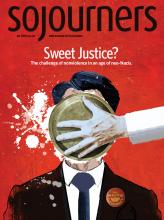THE ARREST OF SEVEN Catholic activists from the Plowshares movement who entered a nuclear submarine base in April again highlights the enduring threats posed by nuclear weapons. The Kings Bay Plowshares carried religious banners promoting peace onto the naval base in Georgia that houses Trident submarines armed with missiles with nuclear warheads. “This weapons system is a cocked gun being held to the head of the planet,” the activists said in a statement as they were arrested.
At a time when President Trump reportedly told Russian President Vladimir Putin that the U.S. would win a nuclear arms race between the two countries, nuclear disarmament efforts feel tenuous. Former U.S. Secretary of Energy Ernest Moniz, who helped broker the Iran nuclear agreement, has warned that the chance of a nuclear launch is “higher than it’s been since the Cuban missile crisis.”
Against this backdrop, the clock is ticking on the New Strategic Arms Reduction Treaty signed in 2010 by President Obama and Russia’s then-President Dmitry Medvedev that limits strategic warheads and delivery systems in the two countries. Unless action is taken to extend that agreement, it will expire in 2021. If that happens, for the first time in more than 40 years the U.S. and Russian nuclear arsenals would operate free of an arms control agreement.
The Pentagon released a nuclear arms policy in February that requests two new types of nuclear weapons, essentially ending the Obama administration’s efforts to reduce the U.S. nuclear arsenal. Defense Secretary Jim Mattis described the changes as a need to “look reality in the eye” and to “see the world as it is, not as we wish it to be.”
Read the Full Article

